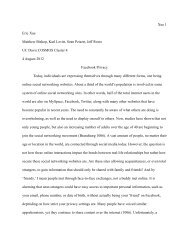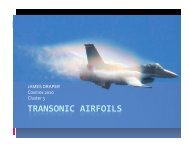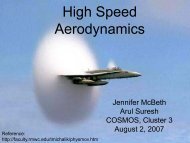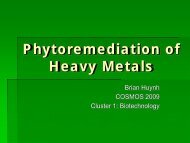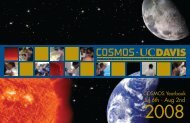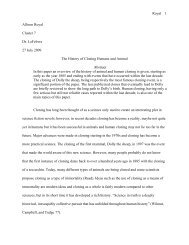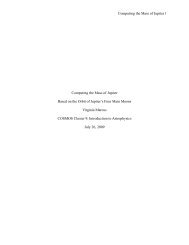Anisha Patel COSMOS UC Davis Cluster 1: Biotechnology
Anisha Patel COSMOS UC Davis Cluster 1: Biotechnology
Anisha Patel COSMOS UC Davis Cluster 1: Biotechnology
Create successful ePaper yourself
Turn your PDF publications into a flip-book with our unique Google optimized e-Paper software.
- During the process of RNAi the double-strandedRNA (dsRNA) is recognized as virus RNA.-Dicer cuts dsRNA into smaller pieces called siRNA-siRNA about 20-25 bp long attaches to RISCcomplex (RNAi induces silencing complex) andforgoes nonspecific immune system application-RISC unwinds the RNA-RISC looks for other RNA with the same or similarsequence-It then binds to the similar sequence and stopsprotein production in the cell
‣ is proving to be useful to analyze quickly thefunctions of a number of genes in a wide variety oforganisms‣ RNAi may facilitate drug screening anddevelopment by identifying genes that can providedrug resistance or genes whose mutant phenotypesare relieved by drug treatment‣ can potentially be used as therapeutic reagentsbecause of their power todownregulate the expression patternof mutant genes in diseased cells
Initially had difficulty on designing an effectivesiRNA sequence lack of accuracy was not only because of itsdependence on the chosen siRNA sequence, butalso on the structure of the siRNA Although the siRNAs are fairly stable in culturedenvironments, it is difficult to enhance the siRNAstability in vivo (in life) however, stability of the siRNA is difficult tocome by without compromising target silencing
Does silencing the human Myb gene by RNAiinhibit the development of the Myeloblastinproteins which influence leukemia cell growth?
‣Myb is the gene thatinfluences leukemia, acancer of blood cells‣The protein Myeloblastinencoded bythese Myb target genes arepresent in the cell’snucleus, bind directly tospecific DNA sequences,and regulate myeloidleukemia cells growthdifferentiation.
Step 1Myeloblastic Cell CultureStep 2Transfection with siRNAStep 3Extract Proteins from CellStep 4Western Blot
1. Culture Myeloblastic cells derived from apatient with acute myeloblastic leukemia in aRPMI 1640 medium with 10% fetal bovine serum.10% Fetal bovine serum
2. Obtain a 20bp sequence of the Myb gene that codes forthe transcription factor the myeloblastin protein.3. Find a company such as Thermo Scientific to request thedouble-stranded siRNA to be made.4. Once the sequence is obtained it should be used totransfect the cell culture.Example:Known DNA: ATTCGGCGTAATGC (part of gene thatcodes for myeloblastin)mRNA: UAAGCCGCAUUACGDouble stranded RNA: UAAGCCGCAUUACGAU<strong>UC</strong>GGCGUAAGC
‣ Lipofectamine•Is a common transfection reagent used in cellularbiology to introduce siRNA into in vitro cell cultures bylipofection.-Lipofection: is a technique used to injectgenetic material into a cell by means of liposomes,which are vesicles that can easily merge with the cellmembrane since they are both made of a phospholipidbilayer.5. Use lipofection to transfect the Myeloblastic culturewith the siRNA
6. Grind approximately five grams of frozen cell tissue in a mortar.i. Add liquid nitrogen, grind slowly as it boils off. Repeat grinding step three times.7. Add a small amount of liquid N2, and swirl to break loose the ground tissue.8. Transfer ground tissue to a 4 degrees C mortar and add 8 mL of Tris extraction bufferi. Grind until tissue and buffer are thoroughly mixed.ii. Prepare Tris Extraction Buffer: 40 mM Tris-HCl (pH 9.5), 50 mM MgCl2, 2%PVPP, 125 U endonuclease/mL, 1 mM PMSF9. Pour mixture into 13 mL centrifuge tube, vortex, and sonicate.i. Vortex for 1 minute, set on ice for 1 minute.ii. Sonicate for 10 pulses (Each Pulse = 2 sec). Set on ice for 3 minutes.iii. Repeat (a) and (b) for a total of two times.10. Centrifuge at 5,000 g for five minutes (6,500 rpm) to pellet debris and recover the supernatant.11. Precipitate protein by adding 4.33 mL of 37.5% TCA plus 1.0% β-mercaptoethanol,bring to a final volume of 13 mL using 37.5% TCA, incubate on ice for 45 minutes,and centrifuge at 14,000 g for 15 min.12. Wash protein pellet 3 times in 80% acetone containing0.05% β-mercaptoethanol.i. Break up protein pellet using small metal spatula.ii. Sonicating in a water bath for five minutes will help disrupt the pellet*.13. Air dry protein pellet in laminar flow hood until all the liquid is gone.
PART 114. Add 10-15 µl of Laemmli buffer to a microtube.15. Add beta mercaptoethanol. (5% of total volume).16. Add a protein sample volume that will contain 100 – 150 µg of protein to the tube withthe other reagents.17. Heat the microtubes at 70 degrees Celsius for 2 minutes, then place on ice18. Pour SDS Buffer into the Western Blot tank.19. Position the acrylamide gels in the gel holder assembly and immerse into the tank.20. Fill the inner compartment (between the two gels) with SDS Buffer.21. Carefully load the samples in the wells.22. Place the lid on the tank and plug it into the power source (100V).23. Run the apparatus at 100V until the samples have passed the stacking gel.24. Turn the voltage up to 160V and allow the samples time to separate; use a pre-stainedmolecular weight marker to determine the end-point of the electrophoresis.25. Cut filter paper in approximately7 x 20 cm pieces.26. Cut PVDF membrane to 7 x 20 cm.27. Pre wet the PVDF membrane using 100% methanol for 10 seconds and immerse indH2O.
PART 228. Soak the filter pads in PVDF Transfer Buffer.29. Assemble the membrane sandwich and place in transfer assembly.30. Fill the transfer tank with PVDF transfer buffer.31. Remove the cooling block from storage at 20 degrees Celsius; place into transferapparatus.32. Place the tank in a refrigerator at 4 degrees Celsius.33. Block the membrane in 5% Non Fat Dry Milk (NFDM) in TBS with 0.05% tween-20for 2 hours.34. Incubate the membrane with the primary antibody for 16 hours at 4 degrees C. Dilutethe antibody with a 2.5% Non Fat Dry Milk (NFDM) in Tween TBS solution. A totalantibody and diluent solution of 5 ml will coat a small membrane in a rotating tube verywell.35. Remove the antibody and perform 3 room temperature washes (10 minutes of rotationeach) with Tween TBS.36. Reblock the membrane in 10% Non Fat Dry Milk (NFDM) in Tween TBS for 10minutes at room temperature.37. Incubate the membrane with the secondary antibody for 30 minutes at roomtemperature. Dilute the antibodywith a 2.5% 38. Non Fat Dry Milk (NFDM) in Tween TBS solution.39. Remove the antibody and perform 3 room temperature washes (10 minutes of rotationeach) with Tween TBS.
PART 340. Prepare the chemiluminscent reagents. It is important that you prepare the ECLsolution just prior to use in order to maximize its effectiveness.41. Lay the membrane face up on an acetate42. Pour the chemiluminscent solution over the membrane, covering it completely.42. After 30 seconds to incubate, place a second acetate over the top and squeeze awayexcess solution.43. Turn out the lights and place the membrane/acetate sandwich in a film cassette with theappropriate film.44. Develop film; remember to use a fixing solution.45. Soak the gel in the horseradish peroxidase dye solution for 30 min.46 . When dry, incubate the membrane in blocking solution for 1 hour.47 . After incubation, incubate (rotate or shake) the membrane with primary antibodysolution (diluted in blocking solution), for 2 hours at room temperature.48 . Wash the membrane in washing buffer (3 x 10 min).49 . Incubate the membrane with secondary antibody-alkaline phosphatase enzymeconjugate solution (in blocking solution) for 1 hour.50 . Wash the membrane in washingbuffer (3 x 10 min).51 . Incubate the membrane in substrate solution, until spots are visible.52 . Stop the reaction – rinse the membrane in distilled water.53 . Air dry the membrane.
controlexperimental• Control hasprotein withMyeloblastinexpression• Experimentalshould havevery little tonone of theMyeloblasticexpressionbecause it hasbeen blockedby the siRNA
I would expect the human Myb gene to be silenced byRNAi to inhibit the development of the Myeloblastinprotein.- This would inhibit the growth of leukemia cellsin the body of the patient with the diseaseBlood with normal amount of white blood cellsBlood with abnormal amount of white blood cells
If the results that I predicted were accurate then Iwould choose to take this project to another levelby testing it in vivo (ex. Mouse model)
-Some studies have suggested that internally siRNAsmay affect developmental processes by influencing theassociation of proteins with genomic DNA, leading togene silencing by prevention of transcription-There is also concern regarding the RNAi’s ability toonly silence the specific gene correlated to stoppingthe production of the protein that influences thecancer.
Kakar, Sham S., Malik, Mohammad. "Suppression oflung cancer with siRNA targeting PTTG". InternationalJournal of Oncology. August 2006. 387-395. Print.Nemunaitis, John, Rao, Donald D., Liu, Shi-He,Brunicardi, F. Charles. "Personalized Cancer Approach:Using RNA Interference Technology". World Journalof Surgery. 2011. 1700–1714. Print.Lutz, Pierre G., Houzel-Charavel, Anne, Moog-Lutz,Christel, Cayre, Yvon E. "Myeloblastin is an Myb targetgene: mechanisms of regulation inmyeloid leukemia cellsgrowth-arrested by retinoic acid". Blood: Journal of theAmerican. 2001. 2449-2456. Print.
Abdelrahim, Maen, Safe, Stephen, Baker, Cheryl,Abudayyeh, Ala. "RNAi and cancer: Implications andApplications". Journal of RNAi and Gene Silencing.2006. 136-145. Print.Smith, Holly. Molecular Tool: RNAi.
Ciccarone, V., Ch. Seven Steps Toward RNAi Success.Ingelbrecht I, Van. Choosing the Right RNAInterference Method for your Research.http://www.sabiosciences.com/newsletter/rnai.htmlDaniel P Cioca1, Yuji Aoki1 and Kendo Kiyosaw.RNA interference is a functional pathway withtherapeutic potential in human myeloid leukemia celllines.
http://www.pawelmazur.org/blog/?tag=mouse-modelshttp://www.connectedkansaskids.com/diagnoses/leukemia.htmlhttp://www.siumed.edu/~dking2/intro/bldcells.htmhttp://concussionresearch.com/http://www.visualphotos.com/image/2x4447391/closeup_human_hands_holding_a_petri_dish_filled




